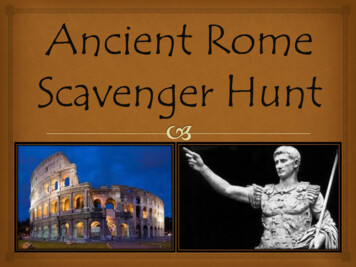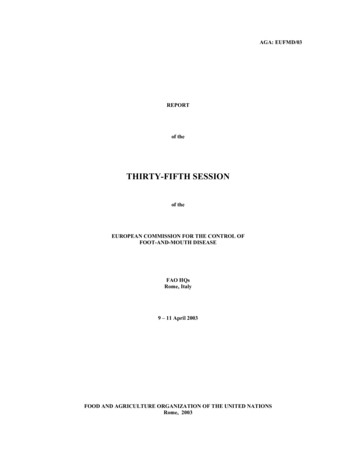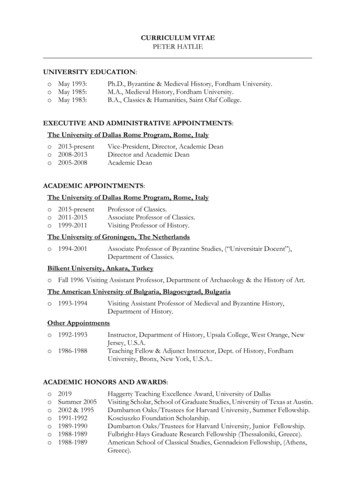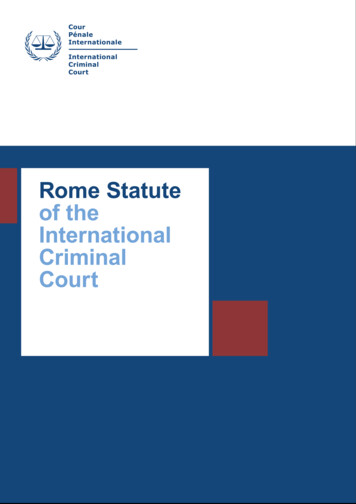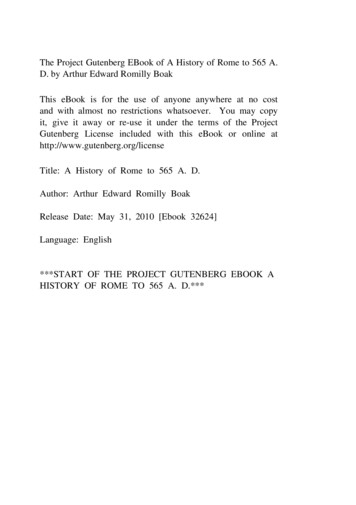
Transcription
The Project Gutenberg EBook of A History of Rome to 565 A.D. by Arthur Edward Romilly BoakThis eBook is for the use of anyone anywhere at no costand with almost no restrictions whatsoever. You may copyit, give it away or re-use it under the terms of the ProjectGutenberg License included with this eBook or online athttp://www.gutenberg.org/licenseTitle: A History of Rome to 565 A. D.Author: Arthur Edward Romilly BoakRelease Date: May 31, 2010 [Ebook 32624]Language: English***START OF THE PROJECT GUTENBERG EBOOK AHISTORY OF ROME TO 565 A. D.***
A HISTORY OF ROMETO 565 A. D.BYARTHUR E. R. BOAK, Ph. D.,Professor of Ancient Historyin the University of Michigan
vNew YorkTHE MACMILLAN COMPANY1921All rights reserved
COPYRIGHT, 1921.By THE MACMILLAN COMPANY.Set up and electrotyped. Published December, 1921.
viiPRINTED IN THE UNITED STATES OF AMERICA
[v]PREFACE[vi]This sketch of the History of Rome to 565 A. D. is primarilyintended to meet the needs of introductory college courses inRoman History. However, it is hoped that it may also prove ofservice as a handbook for students of Roman life and literaturein general. It is with the latter in mind that I have added thebibliographical note. Naturally, within the brief limits of such atext, it was impossible to defend the point of view adopted ondisputed points or to take notice of divergent opinions. Therefore,to show the great debt which I owe to the work of others, andto provide those interested in particular problems with someguide to more detailed study, I have given a list of selectedreferences, which express, I believe, the prevailing views ofmodern scholarship upon the various phases of Roman History.I wish to acknowledge my general indebtedness to ProfessorW. S. Ferguson of Harvard University for his guidance in myapproach to the study of Roman History, and also my particularobligations to Professor W. L. Westermann of Cornell, and to mycolleagues, Professors A. L. Cross and J. G. Winter, for readingportions of my manuscript and for much helpful criticism.A. E. R. BOAK.University of Michigan,October, 1921
[vii]TABLE OF CONTENTSINTRODUCTIONTHE SOURCES FOR THE STUDY OF EARLY ROMANHISTORYPART ITHE FORERUNNERS OF ROME IN ITALYPAGExiiiCHAPTER ITHE GEOGRAPHY OF ITALY3CHAPTER IIPREHISTORIC CIVILIZATION IN ITALY7CHAPTER IIITHE PEOPLES OF HISTORIC ITALY13The Etruscans; the Greeks.PART IITHE EARLY MONARCHY AND THE REPUBLIC, FROM PREHISTORIC TIMES TO 27 B. C.CHAPTER IVEARLY ROME TO THE FALL OF THE MONARCHY25The Latins; the Origins of Rome; the Early Monarchy; Early RomanSociety.CHAPTER VTHE EXPANSION OF ROME TO THE UNIFICATION OF THEITALIAN PENINSULA: C. 509–265 B. C.To the Conquest of Veii, c. 392 B. C.; the Gallic Invasion; theDisruption of the Latin League and the Alliance of the Romans withthe Campanians; Wars with the Samnites, Gauls and Etruscans; theRoman Conquest of South Italy; the Roman Confederacy.33
xA History of Rome to 565 A. D.CHAPTER VITHE CONSTITUTIONAL DEVELOPMENT OF ROME TO 287B. C.47The Early Republic; the Assembly of the Centuries and the Development of the Magistracy; the Plebeian Struggle for Political Equality;the Roman Military System.CHAPTER VIIRELIGION AND SOCIETY IN EARLY ROME61CHAPTER VIIIROMAN DOMINATION IN THE MEDITERRANEAN: THEFIRST PHASE—THE STRUGGLE WITH CARTHAGE,265–201 B. C.67The Mediterranean World in 265 B. C.; the First Punic War; theIllyrian and Gallic Wars; the Second Punic War; the Effect of theSecond Punic War upon Italy.CHAPTER IXROMAN DOMINATION IN THE MEDITERRANEAN: THESECOND PHASE—ROME AND THE GREEK EAST89The Second Macedonian War; the War with Antiochus the Great andthe Ætolians; the Third Macedonian War; Campaigns in Italy andSpain.CHAPTER XTERRITORIAL EXPANSION167–133 B. C.INTHREE CONTINENTS:99The Spanish Wars; the Destruction of Carthage; War with Macedoniaand the Achæan Confederacy; the Acquisition of Asia.CHAPTER XITHE ROMAN STATE AND THE EMPIRE: 265–133 B. C.105The Rule of the Senatorial Aristocracy; the Administration of theProvinces; Social and Economic Development; Cultural Progress.CHAPTER XIITHE STRUGGLE OF THE OPTIMATESPOPULARES: 133–78 B. C.ANDTHE125
TABLE OF CONTENTSxiThe Agrarian Laws of Tiberius Gracchus; the Tribunate of CaiusGracchus; the War with Jugurtha and the Rise of Marius; the Cimbriand the Teutons; Saturninus and Glaucia; the Tribunate of MarcusLivius Drusus; the Italian or Marsic War; the First Mithridatic War;Sulla’s Dictatorship.CHAPTER XIIITHE RISE OF POMPEY THE GREAT: 78–59 B. C.151Pompey’s Command against Sertorius in Spain; the Command ofLucullus against Mithridates; the Revolt of the Gladiators; the Consulate of Pompey and Crassus; the Commands of Pompey against thePirates and in the East; the Conspiracy of Cataline; the Coalition ofPompey, Cæsar and Crassus.CHAPTER XIVTHE RIVALRY OF POMPEYDICTATORSHIP: 59–44 B. C.ANDCAESAR: CAESAR’S166Cæsar, Consul; Cæsar’s Conquest of Gaul; the Civil War betweenCæsar and the Senate; the Dictatorship of Julius Cæsar.CHAPTER XVTHE PASSING OF THE REPUBLIC: 44–27 B. C.185The Rise of Octavian; the Triumvirate of 43 B. C.; the victory ofOctavian over Antony and Cleopatra; Society and Intellectual Life inthe Last Century of the Republic.PART IIITHE PRINCIPATE OR EARLY EMPIRE: 27B. C.–285 A. D.CHAPTER XVITHE ESTABLISHMENT OF THE PRINCIPATE: 27 B. C.–14A. D.The Princeps; the Senate, the Equestrians and the Plebs; the MilitaryEstablishment; the Revival of Religion and Morality; the Provincesand the Frontiers; the Administration of Rome; the Problem of theSuccession; Augustus as a Statesman.CHAPTER XVII205
xiiA History of Rome to 565 A. D.THE JULIO-CLAUDIAN LINE AND THE FLAVIANS: 14–96A. D.226Tiberius; Caius Caligula; Claudius; Nero; the First War of the Legionsor the Year of the Four Emperors; Vespasian and Titus; Domitian.CHAPTER XVIIIFROM NERVA TO DIOCLETIAN: 96–285 A. D.244Nerva and Trajan; Hadrian; the Antonines; the Second War of theLegions; the Dynasty of the Severi; the Dissolution and Restorationof the Empire.CHAPTER XIXTHE PUBLIC ADMINISTRATION UNDER THE PRINCIPATE264The Victory of Autocracy; the Growth of the Civil Service; the Armyand the Defence of the Frontiers; the Provinces under the Principate;Municipal Life; the Colonate or Serfdom.CHAPTER XXRELIGION AND SOCIETY293Society under the Principate; the Intellectual World; the Imperial Cultand the Oriental Religions in Roman Paganism; Christianity and theRoman State.PART IVTHE AUTOCRACY OR LATE EMPIRE: 285–565A. D.CHAPTER XXIFROM DIOCLETIAN TO THEODOSIUS THE GREAT: THEINTEGRITY OF THE EMPIRE MAINTAINED: 285–395 A. D.317Diocletian; Constantine I, the Great; the Dynasty of Constantine; theHouse of Valentinian and Theodosius the Great.CHAPTER XXIITHE PUBLIC ADMINISTRATION OF THE LATE EMPIREThe Autocrat and his Court; the Military Organization; the Perfectionof the Bureaucracy; the Nobility and the Senate; the System ofTaxation and the Ruin of the Municipalities.CHAPTER XXIII333
TABLE OF CONTENTSxiiiTHE GERMANIC OCCUPATION OF ITALYWESTERN PROVINCES: 395–493 A. D.AND THE351General Characteristics of the Period; the Visigothic Migrations; theVandals; the Burgundians, Franks and Saxons; the Fall of the Empirein the West; the Survival of the Empire in the East.CHAPTER XXIVTHE AGE OF JUSTINIAN: 518–565 A. D.369The Germanic Kingdoms in the West to 533 A. D.; the Restorationof the Imperial Power in the West; Justinian’s Frontier Problems andInternal Administration.CHAPTER XXVRELIGIOUSEMPIREANDINTELLECTUAL LIFEIN THELATE385The End of Paganism; the Church in the Christian Empire; SectarianStrife; Monasticism; Literature and Art.EPILOGUECHRONOLOGICAL TABLEBIBLIOGRAPHICAL NOTEINDEX403405415423
[xi]LIST OF MAPSThe Roman Empire in the Second CenturyFrontispieceA. D.PAGEThe Peoples of Italy about 500 B. C.The Environs of RomeRoman Expansion in Italy to 265 B. C.The Expansion of Rome in the MediterraneanWorld 265–44 B. C.The Roman Empire from 31 B. C. to 300 A. D.The Roman Empire in 395 A. D.The Roman Empire and the Germanic Kingdoms in 526 A. D.The Roman Empire in 565 A. D.[xii]14243268204332368380
[xiii]INTRODUCTIONTHE SOURCES FOR THE STUDY OF EARLY ROMAN HISTORYThe student beginning the study of Roman History through themedium of the works of modern writers cannot fail to notewide differences in the treatment accorded by them to the earlycenturies of the life of the Roman State. These differences aremainly due to differences of opinion among moderns as to thecredibility of the ancient accounts of this period. And so it willperhaps prove helpful to give a brief review of these sources, andto indicate the estimate of their value which is reflected in thisbook.The earliest Roman historical records were in the form ofannals, that is, brief notices of important events in connectionwith the names of the consuls or other eponymous officialsfor each year. They may be compared to the early monasticchronicles of the Middle Ages. Writing was practised in Romeas early as the sixth century B. C. and there can be no doubt thatthe names of consuls or their substitutes were recorded from theearly years of the republic, although the form of the record isunknown. It is in the annals that the oldest list of the consuls waspreserved, the Capitoline consular and triumphal Fasti or listsbeing reconstructions of the time of Augustus.The authorship of the earliest annals is not recorded. However,at the opening of the second century B. C. the Roman pontiffshad in their custody annals which purported to run back to the
xvi[xiv]A History of Rome to 565 A. D.foundation of the city, including the regal period. We know alsothat as late as the time of the Gracchi it was customary for thePontifex Maximus to record on a tablet for public inspection thechief events of each year. When this custom began is uncertainand it can only be proven for the time when the Romans hadcommenced to undertake maritime wars. From these pontificalrecords were compiled the so-called annales Maximi, or chiefannals, whose name permits the belief that briefer compilationswere also in existence. There were likewise commentariespreserved in the priestly colleges, which contained ritualisticformulæ, as well as attempted explanations of the origins ofusages and ceremonies.Apart from these annals and commentaries there existed butlittle historical material before the close of the third century B. C.There was no Roman literature; no trace remains of any narrativepoetry, nor of family chronicles. Brief funerary inscriptions,like that of Scipio Barbatus, appear in the course of the thirdcentury, and laudatory funeral orations giving the records offamily achievements seem to have come into vogue about theend of the same century.However, the knowledge of writing made possible theinscription upon stone or other material of public documentswhich required to be preserved with exactness. Thus laws andtreaties were committed to writing. But the Romans, unlike theGreeks, paid little attention to the careful preservation of otherdocuments and, until a late date, did not even keep a record of theminor magistrates. Votive offerings and other dedications werealso inscribed, but as with the laws and treaties, few of thesesurvived into the days of historical writing, owing to neglect andthe destruction wrought in the city by the Gauls in 387 B. C.Nor had the Greeks paid much attention to Roman historyprior to the war with Pyrrhus in 281 B. C., although from thattime onwards Greek historians devoted themselves to the studyof Roman affairs. From this date the course of Roman history
INTRODUCTIONxviiis fairly clear. However, as early as the opening of the fourthcentury B. C. the Greeks had sought to bring the Romans intorelation with other civilized peoples of the ancient world byascribing the foundation of Rome to Aeneas and the exiles fromTroy; a tale which had gained acceptance in Rome by the closeof the third century.The first step in Roman historical writing was taken at theclose of the Second Punic War by Quintus Fabius Pictor, whowrote in Greek a history of Rome from its foundation to hisown times. A similar work, also in Greek, was composed by hiscontemporary, Lucius Cincius Alimentus. The oldest traditionswere thus wrought into a connected version, which has beenpreserved in some passages of Polybius, but to a larger extentin the fragments of the Library of Universal History compiledby Diodorus the Sicilian about 30 B. C. Existing portions of hiswork (books 11 to 20) cover the period from 480 to 302 B. C.;and as his library is little more than a series of excerpts hisselections dealing with Roman history reflect his sources withlittle contamination.Other Roman chroniclers of the second century B. C. also wrotein Greek and, although early in that century Ennius wrote hisepic relating the story of Rome from the settlement of Aeneas,it was not until about 168 that the first historical work in Latinprose appeared. This was the Origins of Marcus Porcius Cato,which contained an account of the mythical origins of Rome andother Italian cities, and was subsequently expanded to cover theperiod from the opening of the Punic Wars to 149 B. C.Contemporary history soon attracted the attention of theRomans but they did not neglect the earlier period. In theirtreatment of the latter new tendencies appear about the timeof Sulla under patriotic and rhetorical stimuli. The aim ofhistorians now became to provide the public with an accountof the early days of Rome that would be commeasurate withher later greatness, and to adorn this narrative, in Greek fashion,[xv]
xviii[xvi]A History of Rome to 565 A. D.with anecdotes, speeches, and detailed descriptions, which wouldenliven their pages and fascinate their readers. Their material theyobtained by invention, by falsification, and by the incorporationinto Roman history of incidents from the history of other peoples.These writers were not strictly historians, but writers of historicalromance. Their chief representative was Valerius Antias.The Ciceronian age saw great vigor displayed in antiquarianresearch, with the object of explaining the origin of ancientRoman customs, ceremonies, institutions, monuments, and legalformulæ, and of establishing early Roman chronology. In thisfield the greatest activity was shown by Marcus Terentius Varro,whose Antiquities deeply influenced his contemporaries andsuccessors.In the age of Augustus, between 27 B. C. and 19 A. D., Livywrote his great history of Rome from its beginnings. His worksummed up the efforts of his predecessors and gave to the historyof Rome down to his own times the form which it preserved forthe rest of antiquity. Although it is lacking in critical acumen inthe handling of sources, and in an understanding for political andmilitary history, the dramatic and literary qualities of his workhave ensured its popularity. Of it there have been preserved thefirst ten books (to 293 B. C.), and books 21 to 45 (from 218 to 167B. C.). A contemporary of Livy was the Greek writer Dionysiusof Halicarnassus, who wrote a work called Roman Antiquities,which covered the history of Rome down to 265 B. C. The earlierpart of his work has also been preserved. In general he dependedupon Varro and Livy, and gives substantially the same view ofearly Roman history as the latter.What these later writers added to the meagre annalisticnarrative preserved in Diodorus is of little historical value, exceptin so far as it shows what the Romans came to believe with regardto their own past. The problem which faced the later Romanhistorians was the one which faces writers of Roman historytoday, namely, to explain the origins and early development of
INTRODUCTIONxixthe Roman state. And their explanation does not deserve morecredence than a modern reconstruction simply because they werenearer in point of time to the period in question, for they hadno wealth of historical materials which have since been lost,and they were not animated by a desire to reach the truth at allcosts nor guided by rational principles of historical criticism.Accordingly we must regard as mythical the traditional narrativeof the founding of Rome and of the regal period, and for thehistory of the republic to the time of the war with Pyrrhuswe should rely upon the list of eponymous magistrates, whosevariations indicate political crises, supplemented by the accountin Diodorus, with the admission that this itself is not infallible.All that supplements or deviates from this we should franklyacknowledge to be of a hypothetical nature. Therefore we shouldconcede the impossibility of giving a complete and adequateaccount of the history of these centuries and refrain from doingourselves what we criticize in the Roman historians.
[1]PART ITHE FORERUNNERS OF ROMEIN ITALY[2][3]
A HISTORY OF ROME TO 565A. D.CHAPTER ITHE GEOGRAPHY OF ITALYItaly, ribbed by the Apennines, girdled by the Alps and the sea,juts out like a “long pier-head” from Europe towards the northerncoast of Africa. It includes two regions of widely differingphysical characteristics: the northern, continental; the southern,peninsular. The peninsula is slightly larger than the continentalportion: together their area is about 91,200 square miles.Continental Italy. The continental portion of Italy consists ofthe southern watershed of the Alps and the northern watershed ofthe Apennines, with the intervening lowland plain, drained, forthe most part, by the river Po and its numerous tributaries. Onthe north, the Alps extend in an irregular crescent of over 1200miles from the Mediterranean to the Adriatic. They rise abruptlyon the Italian side, but their northern slope is gradual, with easypasses leading over the divide to the southern plain. Thus theyinvite rather than deter immigration from central Europe. Eastand west continental Italy measures around 320 miles; its widthfrom north to south does not exceed seventy miles.The peninsula. The southern portion of Italy consists of along, narrow peninsula, running northwest and southeast betweenthe Mediterranean and Adriatic seas, and terminating in twopromontories, which form the toe and heel of the “Italian boot.”The length of the peninsula is 650 miles; its breadth is nowhere
4[4]A History of Rome to 565 A. D.more than 125 miles. In striking contrast to the plains of thePo, southern Italy is traversed throughout by the parallel ridgesof the Apennines, which give it an endless diversity of hill andvalley. The average height of these mountains, which forma sort of vertebrate system for the peninsula (Apennino dorsoItalia dividitur, Livy xxxvi, 15), is about 4,000 feet, and eventheir highest peaks (9,500 feet) are below the line of perpetualsnow. The Apennine chain is highest on its eastern side whereit approaches closely to the Adriatic, leaving only a narrow stripof coast land, intersected by numerous short mountain torrents.On the west the mountains are lower and recede further fromthe sea, leaving the wide lowland areas of Etruria, Latium andCampania. On this side, too, are rivers of considerable length,navigable for small craft; the Volturnus and Liris, the Tiber andthe Arno, whose valleys link the coast with the highlands of theinterior.The coast-line. In comparison with Greece, Italy presents astriking regularity of coast-line. Throughout its length of over2000 miles it has remarkably few deep bays or good harbors,and these few are almost all on the southern and western shores.Thus the character of the Mediterranean coast of Italy, with itsfertile lowlands, its rivers, its harbors, and its general southerlyaspect, rendered it more inviting and accessible to approach fromthe sea than the eastern coast, and determined its leadership inthe cultural and material advancement of the peninsula.Climate. The climate of Italy as a whole, like that ofother Mediterranean lands, is characterized by a high averagetemperature, and an absence of extremes of heat or cold.Nevertheless, it varies greatly in different localities, accordingto their northern or southern situation, their elevation, and theirproximity to the sea. In the Po valley there is a close approachto the continental climate of central Europe, with a markeddifference between summer and winter temperatures and clearlymarked transitional periods of spring and autumn. On the other
THE GEOGRAPHY OF ITALY5hand, in the south of the peninsula the climate becomes moretropical, with its periods of winter rain and summer drought, anda rapid transition between the moist and the dry seasons.Malaria. Both in antiquity and in modern times the diseasefrom which Italy has suffered most has been the dreaded malaria.The explanation is to be found in the presence of extensivemarshy areas in the river valleys and along the coast. Theravages of this disease have varied according as the progressof civilization has brought about the cultivation and drainage ofthe affected areas or its decline has wrought the undoing of thisbeneficial work.Forests. In striking contrast to their present baldness, theslopes of the Apennines were once heavily wooded, and thewell-tilled fields of the Po valley were also covered with tallforests. Timber for houses and ships was to be had in abundance,and as late as the time of Augustus Italy was held to be awell-forested country.Minerals. The mineral wealth of Italy has never been verygreat at any time. In antiquity the most important deposits werethe iron ores of the island of Elba, and the copper mines of Etruriaand Liguria. For a time, the gold washings in the valleys of theGraian Alps were worked with profit.Agriculture. The true wealth of Italy lay in the richness ofher soil, which generously repaid the labor of agriculturist orhorticulturist. The lowland areas yielded large crops of grain ofall sorts—millet, maize, wheat, oats and barley—while legumeswere raised in abundance everywhere. Campania was especiallyfertile and is reported to have yielded three successive cropsannually. The vine and the olive flourished, and their cultivationeventually became even more profitable than the raising of grain.The valleys and mountain sides afforded excellent pasturageat all seasons, and the raising of cattle and sheep rankednext in importance to agricultural pursuits among the country’sindustries.[5]
6[6]A History of Rome to 565 A. D.The islands: Sicily, Sardinia, Corsica. The geographicallocation of the three large islands, Sicily, Sardinia and Corsica,links their history closely with that of the Italian peninsula. Thelarge triangle of Sicily (11,290 sq. mi.) is separated from thesouthwest extremity of Italy by the narrow straits of Rhegium,and lies like a stepping-stone between Europe and Africa. Itssituation, and the richness of its soil, which caused it to becomeone of the granaries of Rome, made it of far greater historicalimportance than the other two islands. Sardinia (9,400 sq. mi.)and Corsica (3,376 sq. mi.), owing to their rugged, mountainouscharacter and their greater remoteness from the coast of Italy,have been always, from both the economic and the culturalstandpoint, far behind the more favored Sicily.The historical significance of Italy’s configuration andlocation. The configuration of the Italian peninsula, long,narrow, and traversed by mountain ridges, hindered rather thanhelped its political unification. Yet the Apennine chain, runningparallel to the length of the peninsula, offered no such seriousbarriers to that unification as did the network of mountains andthe long inlets that intersect the peninsula of Greece. And whenonce Italy had been welded into a single state by the power ofRome, its central position greatly facilitated the extension of theRoman dominion over the whole Mediterranean basin.The name Italia. The name Italy is the ancient Italia, derivedfrom the people known as the Itali, whose name had its originin the word vitulus (calf). It was applied by the Greeks as earlyas the fifth century B. C. to the southwestern extremity of thepeninsula, adjacent to the island of Sicily. It rapidly acquired amuch wider significance, until, from the opening of the secondcentury, Italia in a geographical sense denoted the whole countryas far north as the Alps. Politically, as we shall see, the name fora long time had a much more restricted significance.
[7]CHAPTER IIPREHISTORIC CIVILIZATION INITALYAccessibility of Italy to external influences. The long coastline of the Italian peninsula rendered it peculiarly accessible toinfluences from overseas, for the sea united rather than dividedthe peoples of antiquity. Thus Italy was constantly subjectedto immigration by sea, and much more so to cultural stimulifrom the lands whose shores bordered the same seas as her own.Nor did the Alps and the forests and swamps of the Po valleyoppose any effectual barrier to migrations and cultural influencesfrom central Europe. Consequently we have in Italy the meetingground of peoples coming by sea from east and south and comingover land from the north, each bringing a new racial, linguistic,and cultural element to enrich the life of the peninsula. Thesemovements had been going on since remote antiquity, until, at thebeginning of the period of recorded history, Italy was occupiedby peoples of different races, speaking different languages, andliving under widely different political and cultural conditions.As yet many problems connected with the origin andmigrations of the historic peoples of Italy remain unsolved;but the sciences of archaeology and philology have done muchtoward enabling us to present a reasonably clear and connectedpicture of the development of civilization and the movements ofthese peoples in prehistoric times.The Old Stone Age. From all over Italy come proofs of thepresence of man in the earliest stage of human development—thePaleolithic or Old Stone Age. The chipped flint instruments of
8[8]A History of Rome to 565 A. D.this epoch have been found in considerable abundance, and arechiefly of the Moustérien and Chelléen types. With these havebeen unearthed the bones of the cave bear, cave lion, cave hyena,giant stag, and early types of the rhinoceros, hippopotamus, andelephant, which Paleolithic man fought and hunted. In the BalziRossi caves, near Ventimiglia in Liguria, there have been foundhuman skeletons, some of which, at least, are agreed to be of thePaleolithic Age. But the caves in Liguria and elsewhere, then theonly habitations which men knew, do not reveal the lifelike andvigorous mural drawings and carvings on bone, which the OldStone Age has left in the caves of France and Spain.The New Stone Age. With the Neolithic or New Stone Agethere appears in Italy a civilization characterized by the useof instruments of polished stone. Axes, adzes, and chisels, ofvarious shapes and sizes, as well as other utensils, were shaped bypolishing and grinding from sandstone, limestone, jade, nephrite,diorite, and other stones. Along with these, however, articles ofchipped flint and obsidian, for which the workshops have beenfound, and also instruments of bone, were in common use. TheNeolithic people were also acquainted with the art of makingpottery, an art unknown to the Paleolithic Age.Like the men of the preceding epoch, those of the NeolithicAge readily took up their abode in natural caves. However, theyalso built for themselves villages of circular huts of wicker-workand clay, at times erected over pits excavated in the ground.Such village sites, the so-called fonde di capanne, are widelydistributed throughout Italy.They buried their dead in caves, or in pits dug in the ground,sometimes lining the pit with stones. The corpse was regularlyplaced in a contracted position, accompanied by weapons, vases,clothing, and food. Second burials and the practice of coloringthe bones of the skeletons with red pigment were in vogue.Climatic change.The climate of Italy had changedconsiderably from that of the preceding age, and a new fauna had
PREHISTORIC CIVILIZATION IN ITALY9appeared. In place of the primitive elephant and his associates,Neolithic men hunted the stag, beaver, bear, fox, wolf and wildboar. Remains of such domestic animals as the ox, horse, sheep,goat, pig, dog, and ass, show that they were a pastoral althoughnot an agricultural people.A new racial element. The use of polished stone weapons,the manufacture of pottery, the hut villages and a uniform systemof burial rites distinguished the Neolithic from the Paleolithiccivilization. And, because of these differences, especiallybecause of the introduction of this system of burial which arguesa distinctive set of religious beliefs, in addition to the fact that thedevelopment of this civilization from that which preceded cannotbe traced on Italian soil, it is held with reason that at the openingof the Neolithic Age a new race entered Italy, bringing with it theNeolithic culture. Here and there men of the former age may havesurvived and copied the arts of the newcomers, but throughoutthe whole peninsula the racial unity of the population is shownby the uniformity of their burial customs. The inhabitants ofSicily and Sardinia in this age had a civilization of the same typeas that on the mainland.The Ligurians probably a Neolithic people. It is highlyprobable that one of the historic peoples of Italy was a directsurvival from the Neolithic period. This was the people called theLigures (Ligurians), who to a late date maintained themselves inthe mountainous district around the Gulf of Genoa. In supportof this view it may be urged (1) that tradition regarded themas one of the oldest peoples of Italy, (2) that even when Romewas the dominant state in Italy they occupied the whole westernportion of the Po valley and extended southward almost to Pisa,while they were believed to have held at one time a much widerterritory, (3) that at the opening of our own era they were still ina comparatively barbarous state, living in caves and rude huts,and (4) that the Neolithic cultur
May 31, 2010 · This sketch of the History of Rome to 565 A. D. is primarily intended to meet the needs of introductory college courses in Roman History. However, it is hoped that it may also prove of service as a handbook for students of Roman life and literature in general. It is with the l
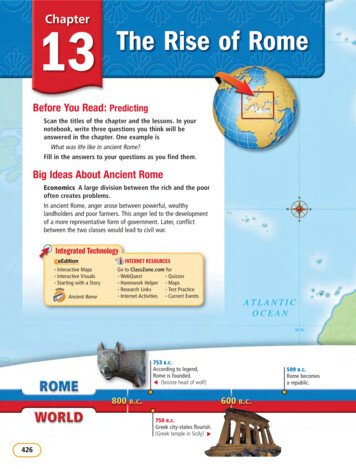
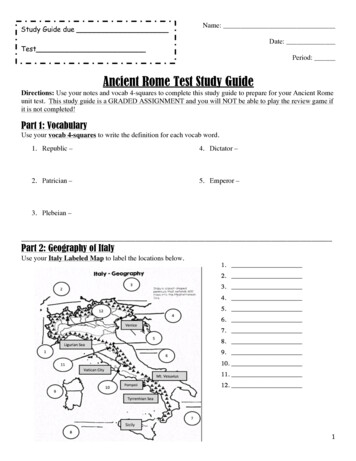


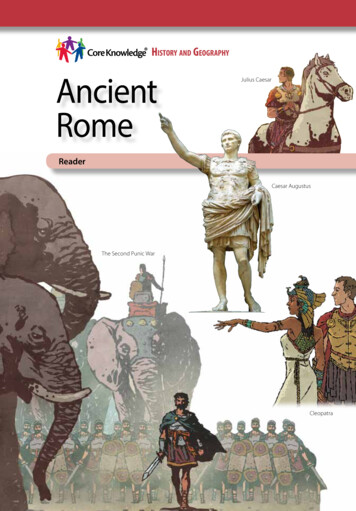
![History of Electronics electricity [Read-Only]](/img/18/history-20of-20electronics-20-20electricity.jpg)
